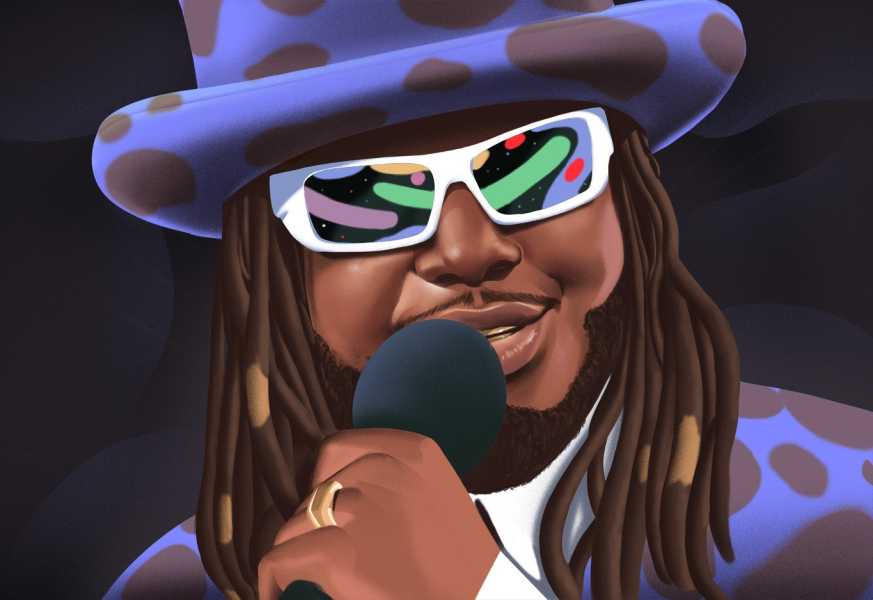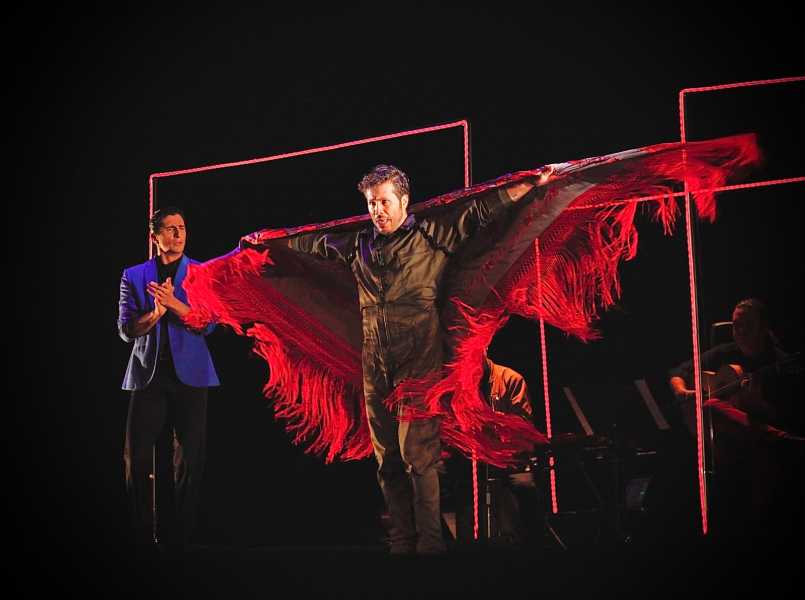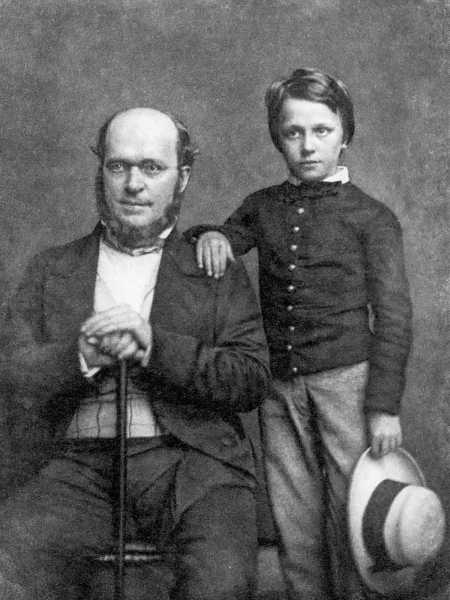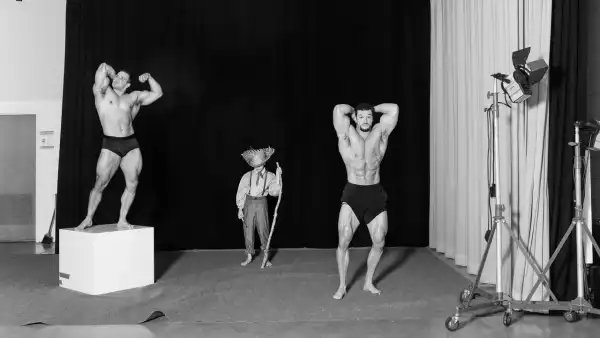
Save this storySave this storySave this storySave this story
Sheldon Pearce
Pearce has covered music for Goings On since 2020.
You’re reading the Goings On newsletter, a guide to what we’re watching, listening to, and doing this week. Sign up to receive it in your in-box.
To call T-Pain’s journey back to the center of pop culture a redemption arc might be underestimating his influence, even at his most marginalized, but in recent years the singer and rapper has become a case study in successful second impressions. Once the purveyor of a liquor-infused, Auto-Tuned R. & B. that pitch-corrected his voice to sound like a libidinous robot, he was soon deemed gimmicky and regressive, a blight on true artistry. A 2014 Tiny Desk concert went a long way toward dispelling the notion that he couldn’t actually sing; winning “The Masked Singer,” in 2019, beating out Donny Osmond and Gladys Knight, ratified his performance credentials. These days, he leans into his newfound brand as a soulful crooner, most recently with more role-playing, on his 2023 album, “On Top of the Covers,” which takes on staples by Sam Cooke, Journey, and Black Sabbath. But T-Pain is still most captivating when he’s navigating the tipsy world of strip joints and night clubs, even with a voice that’s now sweet and unclouded.

Illustration by Richard A. Chance
T-Pain makes a stop in New York on his “Mansion in Wiscansin Party” tour, on June 23, capping a week of stirring performances at Central Park’s Rumsey Playfield, for SummerStage. First, on June 16, the English singer-songwriter Corinne Bailey Rae is joined by the Oscar- and Grammy-nominated singer and instrumentalist Dixson, a secret weapon for Beyoncé. For many years, Rae operated in a sunny pop R. & B. range, but with her 2023 album, “Black Rainbows,” she broke free, expanding into experimental jazz and rock for some of the best music of her career. On June 19, the saxophonist and singer Masego and the backup dancer turned R. & B. front man Jordan Ward—like-minded artists tinkering with jazz and blues—take turns running through songs that reimagine the classic forms they revere. Then on June 22 the accomplished jazz drummer Yussef Dayes, who made his solo début last year with “Black Classical Music,” synchs up with the bassist Aneesa Strings in a perfect convergence of knowledgeable and formidable players.

About Town
Theatre
In “Home,” Samm-Art Williams’s celebrated play from 1979, the blithe, tricksterish farmer Cephus (Tory Kittles) is in love with Pattie Mae (Brittany Inge), who goes off to college and decides not to return to their North Carolina home town, dashing Cephus’s hope to marry her. Cephus ducks the Vietnam draft and does time in prison, then reluctantly skips town and heads north, to the coldhearted streets of New York. Inge and Stori Ayers play a host of characters, giving Cephus’s journey shades of an epic allegory. But the director Kenny Leon creates a shallow stage plane, all bright, saturated color, more interested in horizontality than in depth, making Cephus and his tribulations look like a series of comic-book panels.—Vinson Cunningham (Reviewed in our issue of 6/17/24.) (Todd Haimes; through July 21.)
Classical
Although it took a while for the government to catch up, people have been observing Juneteenth, a commemoration of the end of slavery in the U.S., since the late eighteen-hundreds. For the sixth consecutive year, Carnegie Hall hosts a Juneteenth Celebration, in partnership with the Healing of the Nations Foundation. The evening features the frequent “Les Mis” Javert and acclaimed baritone Norm Lewis, the Grammy-winning and cap-donning jazz singer Gregory Porter, the orchestrator and pianist Joseph Joubert, and the esteemed Chicago-based contemporary-gospel group the Adrian Dunn Singers.—Jane Bua (Carnegie Hall; June 19.)
Art

“Calm Center.”
Art work by Ray Johnson / Courtesy Craig F. Starr Gallery; Photograph by Thomas Barratt
If the late performer, artist, and conceptualist Ray Johnson (1927-95) was known to you primarily as a chief architect of Pop art, this show will come as a revelation—and a relief. Though in much of his work Johnson’s restless energy can be inspiring, one can feel fatigued by his desire to be heard, and noticed. But these exquisite paintings and collages are meditative: Johnson eschews words and symbols for shapes that are soulful and calm. And even as some of the incredible detail he gives to pieces like “Calm Center” (ca. 1949-55) is eye-boggling, you don’t get lost in Johnson’s bravura hand so much as you want to be close to the formal distance that haunts the work. Beautifully lit and laid out, this show is like a well-ordered dream, filled with care and tenderness.—Hilton Als (Craig F. Starr; through June 29.)
Hip-Hop
In 2013, the indie-rap lifers billy woods and Elucid joined forces to become Armand Hammer, a clear-eyed, thrilling guerrilla duo with a penchant for cutting through nonsense. Taking the name of a man dubbed “Lenin's chosen capitalist,” they trade complementary snarky, razor-sharp bars. Elucid, a Queens-born skeptic, can’t help but be blunt, wielding his bludgeoning voice like a hammer and sickle, and his raps press ever forward through the beats. woods, who hides his face in photos, is more elusive; his elliptical verses are built like a labyrinth of postern doors all leading back to the center of the maze. Their music plays up the absurdity of the dystopia it evokes, and their most recent album, “We Buy Diabetic Test Strips” (2023), transmits shrugging revelations from inside the matrix.—Sheldon Pearce (Union Pool; June 23.)
Dance

Photograph by Manuel Garcia
Flamenco Vivo Carlota Santana has been tending the flame of flamenco in New York for more than forty years, but its makeup and character change from one production to the next. In the company’s latest show, “Equilibrio (Clásica/Tradición),” the gifted dancer-choreographer Emilio Ochando is joined by five other dancers and three musicians, including Daniel Jurado, who composed the score. The title marks a search for balance between the classical and the traditional elements of Spanish dance and flamenco, and between the individual and the group. Ochando, a castanet virtuoso, also plays the spoons.—Brian Seibert (Joyce Theatre; June 18-23.)
Movies
Under the guise of modest realism, the writer and director Bridgett M. Davis’s 1996 feature, “Naked Acts”—which is only now being widely released—confronts grand archetypes and unexplored legacies of Black cinema. The twentysomething protagonist, Cicely (Jake-ann Jones), is the daughter of a former blaxploitation star (Patricia DeArcy) and the granddaughter of a theatre actress (Maranantha Quick). Cicely is making her own belated acting début in an independent film about a male artist and his female models, but she rejects the nudity the role requires. Davis presents a woman who, amid memories of neglect and abuse, struggles to find a creative space between being ignored and being exploited. Made when there were few Black female filmmakers, Davis’s starkly symbolic drama exalts the hard-won breakthrough of self-depiction, of controlling the means of production; it opens pathways to a future cinema more radical than itself.—Richard Brody (BAM Rose Cinemas.)

Pick Three
The staff writer Vinson Cunningham shares current obsessions.
1. I was recently wowed, and weirdly moved, by a video of the Brazilian singer Seu Jorge performing “Tempo Perdido” (“Lost Time”), a heartrending song from 1986 by the Brazilian pop band Legião Urbana. I can’t speak Portuguese yet, but now I know that the song is about the sacredness of time, how each morning we wake up on the knife’s edge between the irretrievable and the unknowable. I’ve been poking around Legião Urbana’s smart, playful, trenchant œuvre, making much use of Google Translate as I listen.
2. I remain hopelessly addicted to sports talk—there’s something soothing about the fact that the pleasures of sports can be extended ad nauseam by endless attempts at interpretation. In “First Things First,” on Fox Sports 1, the hosts engage earnestly—rehashing, reframing, twisting their way into needless arguments—and also at a comic remove. They read fake fan mail, hire buglers and break-dancers to raid their set, feather themselves in fake snow. It’s like “Letterman” for sports junkies.

Photograph from Bettmann / Getty
3. “A Chance Meeting: American Encounters,” by Rachel Cohen, from 2004 and recently reissued by New York Review Books, is imaginative nonfiction with a deceptively simple structure: each chapter envisions what happened at a real meeting between two American luminaries—politicians, poets, artists, actors. It begins with a young Henry James and his father sitting for a daguerreotype portrait by Mathew Brady, the great Civil War-era photographer. I’ve been reading a chapter every few days, each a rare piece of rich fudge, reluctant to finish a book so obnoxiously up my alley.
P.S. Good stuff on the Internet:
- The Tally Ho sails again!
- Did David Sedaris originate the aversion to overhead lights?
- Watching a child age over dinner
Sourse: newyorker.com






